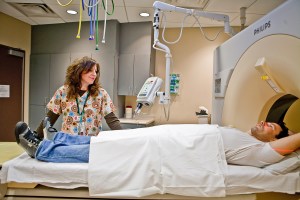Avoiding unnecessary radiation: low-dose X-rays, CT scans at HCMC
Doctors at Hennepin County Medical Center (HCMC) now have a new diagnostic tool that gives them the information they need – without the extra radiation patients don’t need. It’s part of a new approach to medical imaging based on Philips CT (cat scan) and X-ray systems, which includes techniques, programs and practices to ensure the best image quality while reducing radiation exposure to patients and the hospital’s clinical staff.
“Everyone’s concerned about radiation exposure, and the goal of X-ray and CT scanning is to obtain a clear image so we’re able to make an accurate diagnosis,” explains Dr. Chip Truwit, Chief of Radiology at HCMC. “More radiation used to mean clearer image – but not with this new technology. We’re now able to customize the radiation to the patient and deliver only what’s needed to get a clear image. This often results in being able to reduce the patients’ exposure by one-half or even down to one-tenth of what we’d normally use.”
In imaging language, graininess or “noise” reduces image quality. The low-dose scanner technology drastically reduces this “noise.” For example, in order to produce a clear, noise-free image, radiation beams must be strong enough to penetrate through the tissues of a larger patient. But the new technology reconstructs the images – noise free – to generate a readable image without the extra radiation.
“HCMC has made the commitment to be on the leading edge to reduce medical radiation doses,” says Dr. Truwit. “It’s a direct and conscientious decision to reduce radiation exposure to our patients and our staff. Now we can do this and still be able to read the exam without the risk of missing anything.”
HCMC’s intelligent dose management is now incorporated into every aspect of its CT and X-ray imaging studies. Philips technologies automatically calculate the best technique for each exam to deliver the lowest X-ray dose at the optimum image quality. The hospital’s imaging technologists also use Philips DoseAware system to carefully monitor X-ray dose to ensure each patient gets just the right amount to produce a quality image, reducing the need for retakes.
As a Level I Adult and Level I Pediatric Trauma Center, HCMC relies on its advanced radiology services for diagnosis and treatment of its critically injured and ill patients. Its comprehensive radiology services include interventional radiology, X-rays, CT scans, mammography, angioplasty, ultrasound, MRI, and other special procedures available at its downtown campus as well as at Whittier Imaging at Whittier Clinic in South Minneapolis. HCMC offers a full spectrum of inpatient and outpatient hospital and clinical services and has been named one of the nation’s best hospitals by U.S. News & World Report for 15 years in a row.
###



